1. Raič M. Depression and heart diseases: leading health problems. Psychiatr Danub. 2017; 29 Suppl 4(Suppl 4):770–777. PMID:
29278623.
2. Zhang Y, Chen Y, Ma L. Depression and cardiovascular disease in elderly: current understanding. J Clin Neurosci. 2018; 47:1–5. PMID:
29066229.

3. Lichtman JH, Froelicher ES, Blumenthal JA, Carney RM, Doering LV, Frasure-Smith N, et al. Depression as a risk factor for poor prognosis among patients with acute coronary syndrome: systematic review and recommendations: a scientific statement from the American Heart Association. Circulation. 2014; 129:1350–1369. PMID:
24566200.
4. Peters A, McEwen BS. Stress habituation, body shape and cardiovascular mortality. Neurosci Biobehav Rev. 2015; 56:139–150. PMID:
26148986.

5. Thombs BD, Bass EB, Ford DE, Stewart KJ, Tsilidis KK, Patel U, et al. Prevalence of depression in survivors of acute myocardial infarction. J Gen Intern Med. 2006; 21:30–38. PMID:
16423120.

6. Lett HS, Blumenthal JA, Babyak MA, Sherwood A, Strauman T, Robins C, et al. Depression as a risk factor for coronary artery disease: evidence, mechanisms, and treatment. Psychosom Med. 2004; 66:305–315. PMID:
15184688.

7. Pratt LA, Ford DE, Crum RM, Armenian HK, Gallo JJ, Eaton WW. Depression, psychotropic medication, and risk of myocardial infarction: prospective data from the Baltimore ECA follow-up. Circulation. 1996; 94:3123–3129. PMID:
8989119.
8. Lang UE, Borgwardt S. Molecular mechanisms of depression: perspectives on new treatment strategies. Cell Physiol Biochem. 2013; 31:761–777. PMID:
23735822.

9. Correll CU, Solmi M, Veronese N, Bortolato B, Rosson S, Santonastaso P, et al. Prevalence, incidence and mortality from cardiovascular disease in patients with pooled and specific severe mental illness: a large-scale meta-analysis of 3,211,768 patients and 113,383,368 controls. World Psychiatry. 2017; 16:163–180. PMID:
28498599.

10. Feng HP, Chien WC, Cheng WT, Chung CH, Cheng SM, Tzeng WC. Risk of anxiety and depressive disorders in patients with myocardial infarction: a nationwide population-based cohort study. Medicine (Baltimore). 2016; 95:e4464. PMID:
27559951.
11. Chan JN, Lee JC, Lee SS, Hui KK, Chan AH, Fung TK, et al. Interaction effect of social isolation and high dose corticosteroid on neurogenesis and emotional behavior. Front Behav Neurosci. 2017; 11:18. PMID:
28270754.

12. Shah SU, White A, White S, Littler WA. Heart and mind: (1) relationship between cardiovascular and psychiatric conditions. Postgrad Med J. 2004; 80:683–689. PMID:
15579605.

13. Stover PJ. Physiology of folate and vitamin B12 in health and disease. Nutr Rev. 2004; 62(6 Pt 2):S3–S13. PMID:
15298442.
14. Trebatická J, Dukát A, Ďuračková Z, Muchová J. Cardiovascular diseases, depression disorders and potential effects of omega-3 fatty acids. Physiol Res. 2017; 66:363–382. PMID:
28248536.

15. Young SN. Folate and depression: a neglected problem. J Psychiatry Neurosci. 2007; 32:80–82. PMID:
17353937.
16. Golledge J. Abdominal aortic aneurysm: update on pathogenesis and medical treatments. Nat Rev Cardiol. 2019; 16:225–242. PMID:
30443031.

17. Sakalihasan N, Michel JB, Katsargyris A, Kuivaniemi H, Defraigne JO, Nchimi A, et al. Abdominal aortic aneurysms. Nat Rev Dis Primers. 2018; 4:34. PMID:
30337540.

18. Liberzon I, Abelson JL, Amdur RL, King AP, Cardneau JD, Henke P, et al. Increased psychiatric morbidity after abdominal aortic surgery: risk factors for stress-related disorders. J Vasc Surg. 2006; 43:929–934. PMID:
16678685.

19. King AP, Abelson JL, Gholami B, Upchurch GR Jr, Henke P, Graham L, et al. Presurgical psychological and neuroendocrine predictors of psychiatric morbidity after major vascular surgery: a prospective longitudinal study. Psychosom Med. 2015; 77:993–1005. PMID:
26461854.
20. Nyrønning LÅ, Stenman M, Hultgren R, Albrektsen G, Videm V, Mattsson E. Symptoms of depression and risk of abdominal aortic aneurysm: a HUNT study. J Am Heart Assoc. 2019; 8:e012535. PMID:
31642357.

21. Lee YH, Han K, Ko SH, Ko KS, Lee KU. Taskforce Team of Diabetes Fact Sheet of the Korean Diabetes Association. Data analytic process of a nationwide population-based study using National Health Information Database established by National Health Insurance Service. Diabetes Metab J. 2016; 40:79–82. PMID:
26912157.

22. Kozela M, Bobak M, Besala A, Micek A, Kubinova R, Malyutina S, et al. The association of depressive symptoms with cardiovascular and all-cause mortality in Central and Eastern Europe: prospective results of the HAPIEE study. Eur J Prev Cardiol. 2016; 23:1839–1847. PMID:
27154591.

23. Adamis D, Ball C. Physical morbidity in elderly psychiatric inpatients: prevalence and possible relations between the major mental disorders and physical illness. Int J Geriatr Psychiatry. 2000; 15:248–253. PMID:
10713583.

24. Silvestri V, Simonte G. Aortic pathology in systemic lupus erythematosus: a case report and review of literature. Ann Vasc Surg. 2017; 43:312.

25. Jost CJ, Gloviczki P, Edwards WD, Stanson AW, Joyce JW, Pairolero PC. Aortic aneurysms in children and young adults with tuberous sclerosis: report of two cases and review of the literature. J Vasc Surg. 2001; 33:639–642. PMID:
11241138.

26. Alexopoulos GS. Depression in the elderly. Lancet. 2005; 365:1961–1970. PMID:
15936426.

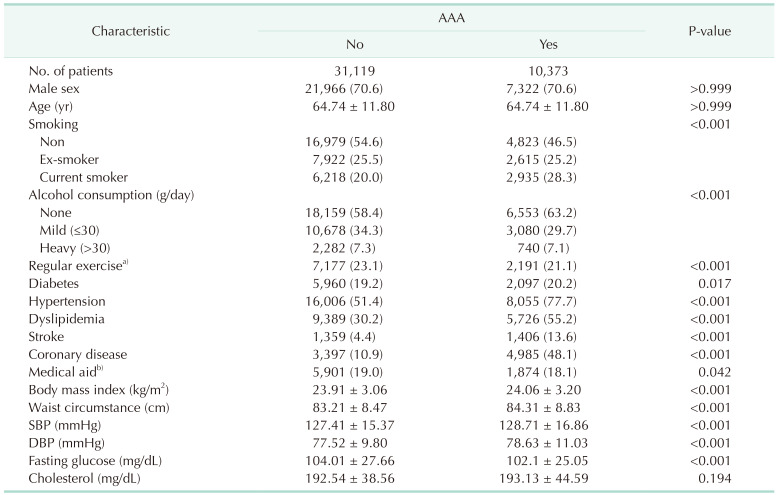
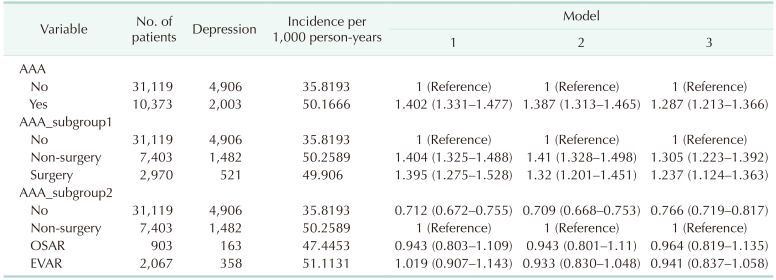





 PDF
PDF Citation
Citation Print
Print



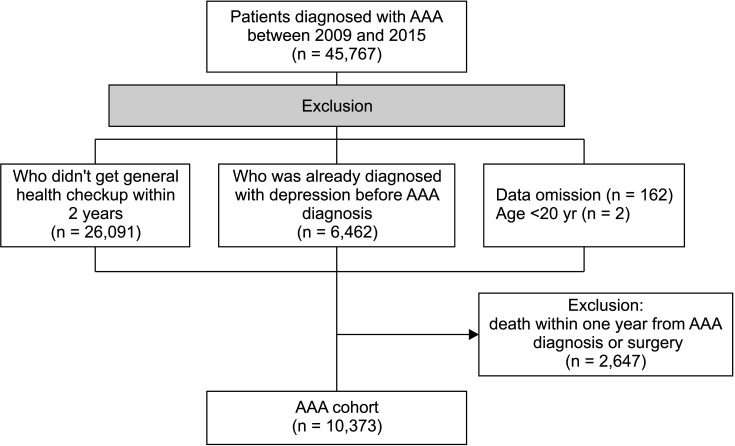

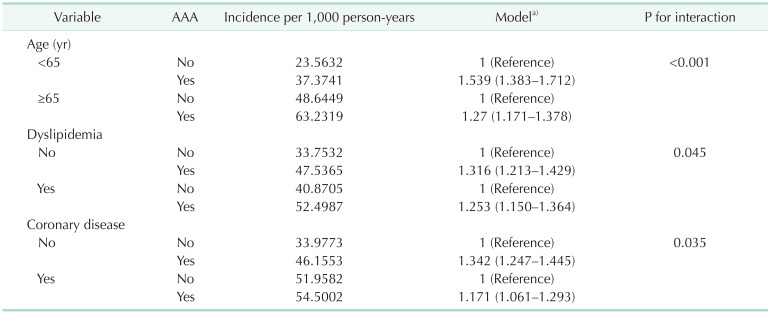
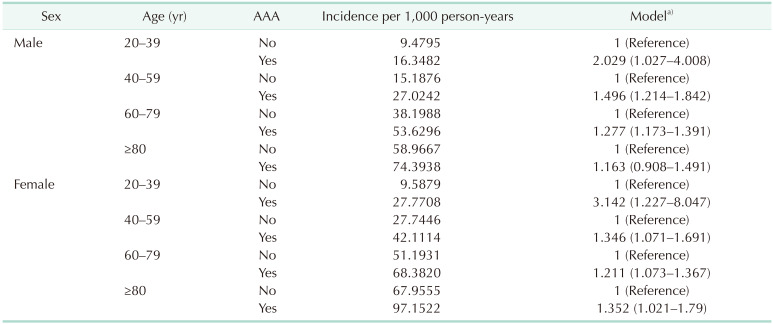
 XML Download
XML Download